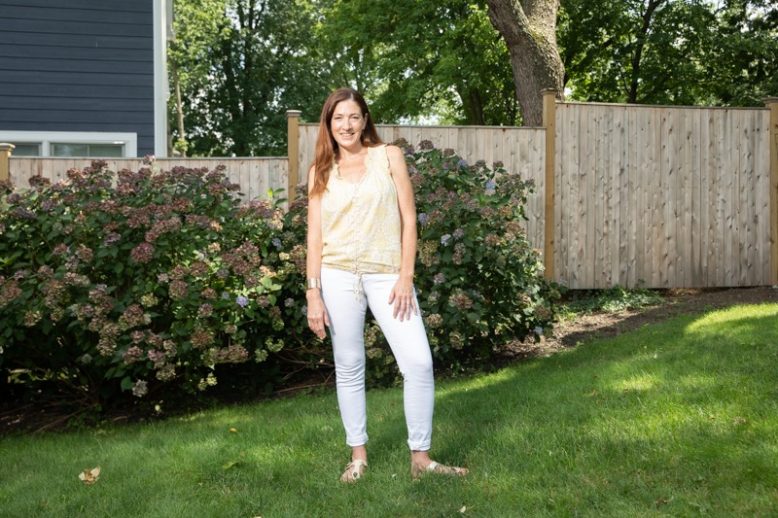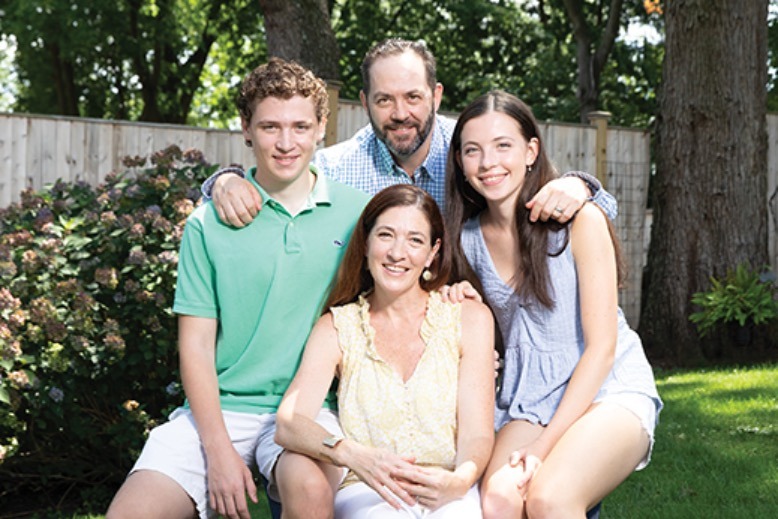
March began with all the familiar rituals of suburban life in New Jersey: spring sports for my high school twins, volunteer projects, and talk of warm-weather get-togethers with friends. Peppered into that were rumblings of a virus that had taken hold overseas. I watched initial news reports with sadness, but the crisis seemed a world away. Two weeks later, on March 21, Governor Murphy put New Jersey in a near-total lockdown. The coronavirus was inching closer to home.
Seemingly overnight, cases skyrocketed in the area. I worried about my husband and my daughter, who both have asthma. In my eyes, they were the vulnerable ones, not me. I was an avid runner, ate a healthy diet, and hadn’t been to the doctor for anything more than a sinus infection in decades. And then, one night in April, the discovery of a lump in my breast changed everything. Here is a chronicle of my harrowing journey through cancer during the time of coronavirus.
[RELATED: The New Us: Stories of Resilience and Hope]
APRIL 23
I found a lump last night out of the blue. I’m sure I’m just being paranoid. After all, I have no family history, no genetic markers. Just to be sure, I e-mailed the doctor and she agreed to see me alone in a small satellite office. I can’t help thinking a medical office is the worst place to be right now. I’m more nervous about catching coronavirus than I am about the possibility of cancer.
Throughout the visit, I’m waiting for the doctor to say it’s nothing. I’d been through this before, and it turned out to be a cyst. Instead, she turns to me and says, “You need to get an ultrasound and biopsy. I’ll text in favors to get you in. A lot of doctors aren’t taking patients.” I nod as a courtesy, but her words don’t register at first.
It isn’t until I hear her on the phone saying, “Forty-six-year-old woman with a lump in left breast” that it hits me. This is happening. And in the middle of a pandemic. I fight with myself—one part of me wanting to fall apart, needing to let the tears out, and the other reminding me not to touch my face or wipe my eyes. But it’s useless. Within minutes, my mask is soaked through. The doctor tries to comfort me. “It’s going to be okay. I will help you,” she assures me, but that six feet of space between us feels suddenly like a chasm. How can I do this with Covid-19 all around?
Back home that night, the confines of quarantine steal the small luxury of being able to shelter my kids from what is happening for a little while longer. With no school or after-school sports to keep them occupied, they recognize that something is wrong. “Do you have coronavirus?” my son asks. He heard me on the phone saying something about the doctor.
“No,” I reply, unable to keep my voice steady, “but there is a chance I might have cancer.”
APRIL 24
Biopsy and ultrasound today. Outside the entrance to the medical-arts building, a police officer directs me to tables inside with nurses in masks. One takes my temperature and reels off the requisite questions: “Have you been in contact with anyone with the virus? Have you shown any symptoms?” Shaking my head no, I almost start to cry. This can’t be real.
They allow me to pass. The lonely hallways seem to scream: You shouldn’t be here. In the waiting room, signs calling for six feet of separation occupy most of the chairs, but it seems unnecessary; I’m the only one here.
The surgeon, upon seeing the mass on the ultrasound, says it looks “suspicious.” He performs the biopsy and says results will come in a few days. I’ve made a promise to myself—no tears today, the mask needs to stay dry. I rush toward the exit pumping hand sanitizer from every dispenser along the way. I get to my car, rub in more sanitizer, pull off my mask, and finally the tears start to flow. “Why is this happening now?” I ask myself out loud.
APRIL 27
The surgeon called this morning. It’s cancer. All I can think is, I can’t do this, not now. Not when hospitals are surging with Covid cases.
By noon, I am back at the surgeon’s office—with my husband this time. The doctor explains my options. He recommends a lumpectomy, which means just removing the tumor. He assures this is good news.
It’s a long conversation. I hear bits of information about tumors being hormone receptive, HER2 negative, and how hopefully, I’ll get to keep my “beautiful hair.” I am glad the doctor allowed my husband to be there taking notes. All I can think of is the masks. I’ve never actually seen the surgeon’s face, and he’s never seen mine. I would just like to see his smile.
The surgery can be scheduled for next week. With no elective surgeries being performed, I can be in and out. I won’t even have to stay overnight. My head is swimming. Next week? Will it be safe in the hospital then? And yet, coronavirus or not, all I want is to get this cancer out of my body. What choice do I have?
After the meeting, the surgery coordinator tells us I need to get an MRI. “Lucky for us,” she says, “they can take you right away”—no other patients there either. To get there we will need to go to the main hospital, which is connected to the medical arts center by a long passageway. Again, no visitors—just a few doctors and nurses in PPE. We move past them, hugging the walls.
As I climb onto the metal table to begin the MRI, I ask, “Do I have to wear the mask for this?” The procedure seems stressful enough on its own, let alone with a mask that makes it harder to breathe.
“You don’t have to, but I would,” the technician says. By her response, I can see there is no protocol for this yet. No one knows for sure what is safe, even here in a hospital. So I keep it on for the 40 long minutes lying face down, perfectly still.
Later, as we head for the elevator, a hospital worker in something like a space suit comes toward us with a patient on a gurney. Plastic sheeting covers the patient, who appears to be wearing a gas mask. I jump back. Are our homemade fabric masks enough to protect us?
We hurry to the elevator, but a cleaning woman stops us. “You need to wait,” she says. “They are sanitizing it. He was a Covid patient.”
“Can we take the stairs?” I ask.
“No, and there’s only one elevator in this area.”
I wonder if there’s another way out.
“You’d have to go through the emergency room,” she tells us. Obviously, not a good option. Finally, we get on the elevator. I hold my breath.
MAY 1
It’s hard not to think about coronavirus all the time. It’s all over the news. Even the commercials have pivoted to staying home, washing your hands and maintaining six feet of separation. But for me, it’s different now. It’s not just about avoiding Covid-19. I need to get through the cancer. I keep thinking about how I was the healthy one, the one with the strong immune system. But now the surgery, the radiation treatments, are about to leave me weakened.
MAY 7
Surgery today. I have to go alone. I was up half the night worrying. Not just about the surgery, but about my new vulnerability. How can I worry about wearing a mask, not touching my face, and sanitizing my hands when I’m under anesthesia?
At the hospital, the entry road is lined with reminders: “NO visitors.” The parking garage is nearly empty. My husband walks me to the door as a police officer reminds us again, “No visitors.” A few feet away, an elderly couple cling to one another. Is this their last goodbye?
I turn to my husband. “You can do this,” he says. “It’s going to be okay.” I want to believe him, but what if he’s wrong? What I need most today is him. To hold my hand, to keep me distracted and be there when I wake up. I hate coronavirus for taking that away from me.
Inside, I sit alone, more afraid than I’ve ever been. The nurse comes in covered head to toe in protective gear. Before she begins, she holds up her photo ID badge, “I know I look a little scary. This is what I look like in real life, and I’m going to take care of you today.”
I smile, my eyes tearing again. “Thank you, this is so hard with no family.”
“Today we are your family,” she says.
I have no choice but to believe her.
JUNE 15
Started radiation today. It’s more psychologically draining than I expected. Sitting in the waiting room with other cancer patients, all just as scared to be there. Walking into the treatment room beyond the thick, heavy door with its ominous sign: “Warning radiation.” Alone in the room, the machines moving all around me, and a piercing beep as the radiation is released. I’ve got to endure 20 more sessions over the next five weeks. That feels like enough to go through without worrying about the virus, too.
JULY 10
I’m finishing my fourth week of radiation treatments. What I’ve come to dread the most is the temperature check and screening questions on the way in. Every day, over and over.
When I started treatments, the hospital was still quiet. There was some comfort in that. I didn’t have to worry about being infected by other people. But the state has begun to reopen, and people are venturing out. I now have to wait in line to enter the hospital. In the hallways, there are other patients to avoid.
The routine is wearing on my family, too. Surgery and treatments have meant months of housebound isolation, not just for me, but for everyone in my house. We can’t even go to the grocery store. The neighborhood kids have begun riding bikes together and meeting up in the nearby park. Mine are quarantined inside with me. I wrestle with the guilt. Is the emotional toll of isolation worse than the risk of disease and the potential interruption of my treatments?

Darcey Gohring, center, with husband Oliver and children Christian, left and Anna. Photo by Christopher Lane
JULY 18
My treatments are over, and the doctors tell me I am cancer free. I am elated. If things were normal, we’d go on a trip to celebrate. And yet, Covid-19 is still here—and will be forever linked with my cancer. The virus shaped every part of the journey, making me not just realize all I took for granted, but also ponder how fragile life is and how much more I hope to do with mine.
Darcey Gohring, a former research assistant for New Jersey Monthly, is a New Jersey–based freelance writer. She is completing her first novel.
